
Livre de la chasse
Bequest of Clara S. Peck, 1983
Hunting and Slaying Wild Cats
Hunters did not usually quest wild cats, but would go after them when they were encountered in the course of seeking other game, such as foxes or hares. Here, what Phoebus called a cat-leopard (lynx), is pursued by equestrian hunters with spears, backed up with hounds and two grooms also armed with spears. The cat-leopard was dangerous because it had claws like a leopard and such a fierce bite that it could severely injure a hound. A second cat has sought refuge in a tree, from which it could easily be shot down with a bow or crossbow.
Hunting and Slaying the Otter
The otter, like the fox, was little loved because it preyed on fish, not only in rivers but in ponds, cutting into the food supply. Since the otter left the water at night, the lymerer, with specially trained lymers, picked up his trail at the water's edge, where footprints and characteristic droppings would indicate both the direction and point at which the otter left or entered the water. For a single river, as depicted here, Phoebus suggested the use of four men–—two on each bank, one to go upstream, the other down. Hunters, with spears or tridents, stab the otter. Were they to miss, the otter would still end up in the weighted nets that were spread above and below the otter's couch (lair). A second otter has been captured in a tree trunk. The otter would then be skinned and his cooked flesh would provide a feast for the dogs.
Image courtesy of Faksimile Verlag Luzern
